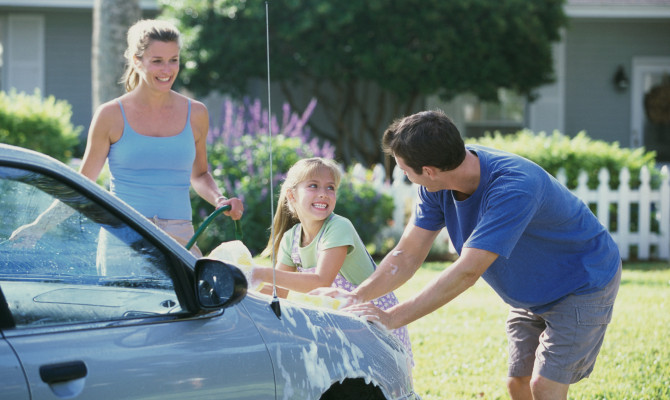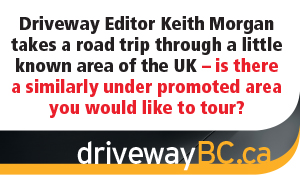Unnecessary weight increases fuel consumption and some of that extra weight could be in the form of mud and dirt on your vehicle’s undercarriage…
If a road trip is part of your vacation plans this summer, it’s time to get the horseless chariot prepared.
That means cleaning it inside and out and performing some important maintenance to ensure you get the best fuel economy.
In most parts of B.C., the swap from winter tires to all-season or summer tires is already well under way (studded winter tire removal is mandatory by April 30). Winter tires are made with a softer and stickier rubber compound that wears faster and increases fuel consumption at higher temperatures. They also tend to be noisier and you’ll hear them even more, now that you can finally roll down the windows.
You may also be dragging around too much junk in the trunk, such as that snow shovel you always pack during in the winter months. Unnecessary weight increases fuel consumption and some of that extra weight could be in the form of mud and dirt on your vehicle’s undercarriage.
(Road salt is probably also trapped in that muddy mess, which is a corrosion accelerant that your vehicle’s body doesn’t need.)
While you’re poking around in the trunk, take a look under the floor cover. Water leaking into the vehicle tends to accumulate in the lowest spots, or maybe that’s why it’s called a spare-wheel well. If the spare is a conventional tire, check its inflation pressure and, while you’re at it, make sure that the emergency jack and tool kit are also in good working order.
An easy check and repair item is lighting. You may need some help confirming that the brake and backup lights are functioning at the rear. Otherwise, it’s a simple walk-around check that should include the turn signals and headlights (both low and high beams) and don’t forget the license plate and those little side marker lights. If you’ve got a vehicle with a headlight (clear plastic) cover that’s showing its age, there are some good products on the market now that help restore clarity.
Wiper blades are another easy check and replace item. A build-up of grease or grim on the windshield will also reduce the effectiveness of the wipers. Clean the rubber wiper blade with a soft cloth soaked in the glass cleaner. In B.C., those windshield wipers typically work harder than anywhere else in Canada and life expectancy can be less than a year.
If they’re still streaking, chattering or generally not doing the job – replace them.
Getting back to tires, a loaded vehicle driven at highway speeds for prolonged periods in hot weather conditions can be a punishing test for tires and the dreaded blow-out is a real concern. Even a tire that looks okay and has plenty of tread remaining may not be in great shape. The “best before” date on most passenger tires is eight years old and you should be able to find a date of manufacture stamped somewhere on sidewall of the tire.
A tire also performs best, lasts longer and provides best fuel economy when its internal pressure is set at a level recommended by the vehicle manufacturer, and checked on a regular basis. The tire decal, with optimal front and rear recommended tire pressures, is usually on the driver’s door or door jam. If not, the owner’s manual should give you the information and/or tell you where the tire decal is located. A single under-inflated tire (by about 6 psi /40 kPa) can cause a 3 per cent increase in fuel consumption.
Using a grade of fuel with a lower octane rating than recommended by the vehicle manufacturer may cause the engine to ping or knock on hard acceleration or when climbing hills, which is not good for the engine!
On the other hand, using a higher-octane fuel than your vehicle’s engine needs is generally a waste of money. That said, the pricier fuel may also contain some additional cleaner additives, which is good.
Have a great summer and a safe driving vacation.
Recent Comments
- { Enjoyed your Forest of Bowland in the BMW X5M, particularly the photo of the BMW in front of the main part of Stonyhurst College where... }
- { Bantam designed the Jeep, not Willy's or Ford. The American military gave the original Bantam prototype to Willys and Ford to copy. There is plenty... }
- { All Escalades come with a 6.2-lilter V8 engine that produces 420 horsepower. A six-speed automatic is the only transmission offered and drives the rear wheels.... }
- { Alexandra is an excellent journalist. }
Popular Posts
- Journey to a ‘Sparkling’ Luxury Okanagan Resort “Four lucky readers will put a Dodge Journey’s weekend-...
- The Need For Speed: Hike Those Highway Limits More than half of those polled believe the province sho...
- Drives-U-Crazy… Erratic drivers. An early morning drive from Kelowna to Vancouver is nor...
- Readers Respond: The Pros and Cons of Increasing B.C. Speed Limits Increasing the speed limits will only increase risk to...
- Honda CR-V Review: The Compact Crossover To Get Things Done The CRV is a very stylish and aerodynamic crossover veh...







